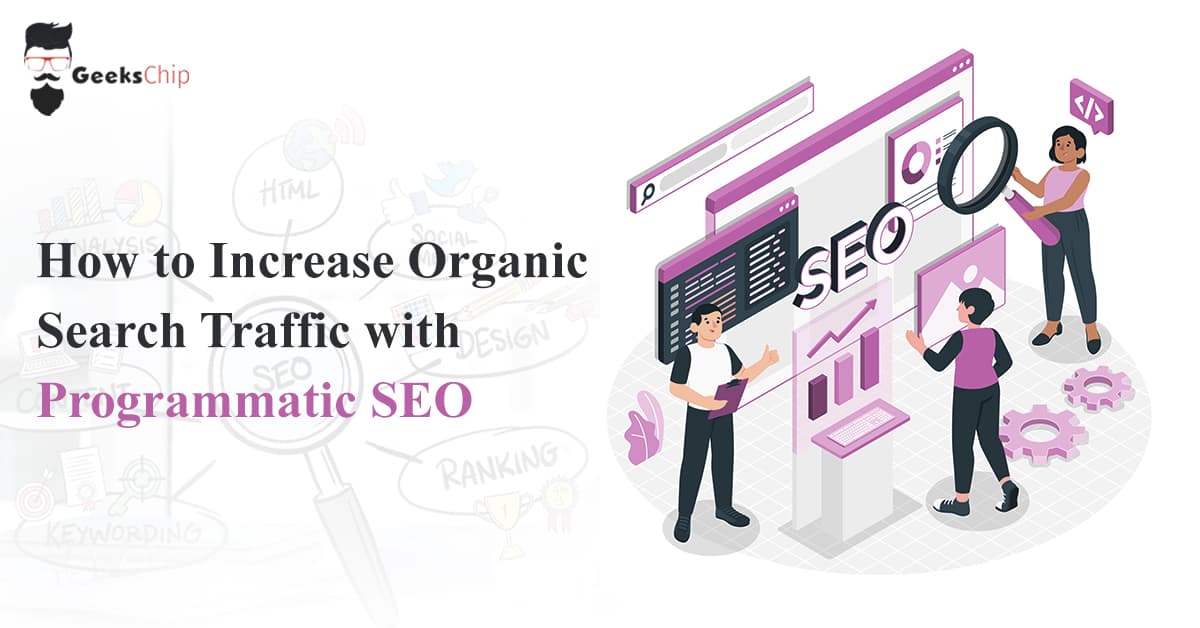We have all heard of SEO, but have you heard about Programmatic SEO (PSEO)? A growing number of businesses are increasingly utilizing this previously unexplored approach of producing high-ranking content on a large scale to dominate search results relating to their sector and significantly improve their organic traffic.
Programmatic SEO uses data-driven and automated processes to optimize a website’s search engine visibility and organic search rankings. It involves leveraging technology and algorithms to streamline and enhance various aspects of SEO, such as keyword research, content optimization, on-page SEO, and more. Programmatic SEO aims to make SEO strategies more efficient and effective by reducing manual work and improving the targeting of SEO efforts.
What Is Programmatic SEO?
- Programmatic SEO (PSEO) uses automation, keyword targeting, and data analysis to create and optimize many high-ranking landing pages at scale to boost search engine rankings.
- Programmatic SEO is the creation of landing pages on a large scale SEO to rank on search engine results pages (SERPs).
- It is quicker to achieve the same goal, to rank on Google.
- We can create landing pages from a database, landing page template, and automation.
- These pages involve specific keyword research, just like regular SEO.
- Tripadvisor, Yelp, and Walmart are a few of programmatic SEO examples.
Yelp: restaurants, barbershops, gyms
Walmart: groceries, electronics
Tripadvisor: things to do, hotels
Here Are Some Strategies To Increase Organic Search Traffic With Programmatic SEO:
1. Keyword Research and Optimization:
- Use keyword research tools to identify low-competition and high-value keywords relevant to your niche.
- Implementation of keywords strategically in your website’s meta tags, headers, and content.
2. Content Creation and Optimization:
- Create high-quality, engaging, yet informative content that fulfills your targeted audience's interests and needs.
- Use programmatic tools for analyzing content performance, identifying gaps, and suggesting improvements.
3. Technical SEO:
- Regularly check out technical SEO issues like slow-loading pages, broken links, and mobile compatibility.
- To fix technical problems efficiently and quickly, use automated tools.
- Check out the best SEO services in Hyderabad.
4. User Experience (UX):
- Maintain a user-friendly website for a positive user experience.
- Programmatic tools can help in analyzing user behavior and suggest UX improvements.
5. Backlink Building:
- Concentrate on obtaining high-quality backlinks from trustworthy websites in your field.
- Use tools to find link-building possibilities and monitor your backlink profile.
6. Local SEO:
- Optimize the website for local search results if you have a physical presence.
- To administer local listings and collect reviews, use programmatic SEO tools.
7. Voice Search Optimization:
- As voice search continues to grow, ensure to optimize your content for voice search queries.
8. Content Distribution And Promotion:
- Utilize marketing channels such as email marketing, social media platforms, and many more to promote your content and reach a wider audience.
- Always use the best digital marketing services available for your business to gain organic search traffic.
9. Analytics And Data Insights:
- Track and analyze website performance, organic traffic patterns, and user behavior using programmatic SEO tools.
- Make data-driven decisions to continuously improve your SEO approach.
10. AI and Machine Learning:
- Consider AI-powered SEO solutions that can automate operations such as content development, data analysis, and even predictive SEO analytics.
11. Adapt to Algorithm Changes:
- Keep up with the current search engine algorithm adjustments and adapt your search engine optimization initiatives accordingly.
12. Mobile Optimization:
- Have your website optimized for mobile devices as mobile search continues to grow.
- Mobile optimization has been a tremendous WhatsApp marketing strategy for businesses.
The Three Pillars of Programmatic SEO
The programmatic SEO strategy always focuses on low-competition keywords with the highest conversion probability.
1. Low-Competition Keywords:
- Programmatic SEO focuses on targeting keywords that have less competition to increase the chances of ranking pages.
- We can find keywords by measuring the competitiveness of search terms using a metric called Keyword Difficulty (KD)
- The Programmatic SEO project will target the keywords with a low KD%.
- An intensive SEO approach is typically required for difficult keywords to deliver the quality required to compete in the SERPs.
2. Search Intent:
Search Intent is nothing but the user's primary purpose when they land on your website.
There are four types of user intent.
- Navigational: When the user looks for a particular page.
- Informational: When users want to learn about a specific topic.
- Commercial: When a user does some research and makes a purchase decision.
- Transactional: when a user wants to complete a specific task or purchase.
3. User Experience (UX):
- A great UX will keep and convert the audience that lands on your page.
- The automation that makes the landing page scaling possible can affect the UX.
- Therefore, you need fast-loading pages with helpful, creative, and unique content on every page.
- Maintain a high-quality standard using automation tools to create landing pages and add human-written content.
- Using a landing page template with the same AI-generated copy for ranking can lead to low-quality or thin content penalties.
Pros and Cons of Programmatic SEO
Programmatic SEO differs from traditional SEO in its methodology. However, PSEO is a valid technique to increase organic search traffic and conversions in addition to your standard plan of action.
1. Pros of Programmatic SEO
- Once you've created your landing page template, web pages are simple to grow.
- You may target whole keyword categories and rank for all possible queries simultaneously.
- Search visibility is increased by targeting low-competition keywords and ranking on Google.
- The more your exposure and search traffic, the more probable you will develop backlinks.
- Promoting sales by targeting audiences that are ready to buy.
2. Cons of Programmatic SEO
- Coding abilities are required to create a programmatic SEO template.
- Investing in the correct no-code tools comes with a more significant initial expense.
- The development of low-quality or duplicate material may violate Google's Spam Policies.
- Indexing all of your web pages might be difficult.
- Programmatic SEO is still a time-consuming and labor-intensive process that needs continual maintenance and monitoring.
Conclusion:
Programmatic SEO isn't an all-embracing solution, but it may be profitable if used effectively for the right firm. Although the stages in this tutorial are high-level, no-code tools and methods like the ones I explain here do not need substantial expertise or hours of coding. If you devote the time to study and follow the suggestions, you may do it in a week.






























